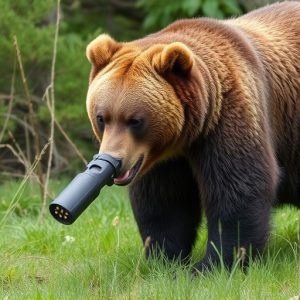GrizGuard Bear Spray: Safety, Composition, and Environmental Impact
In the vast backcountry, encounters with bears can range from awe-inspiring to life-threatening. Und…….
In the vast backcountry, encounters with bears can range from awe-inspiring to life-threatening. Understanding bear-human interactions underscores the critical need for effective deterrents like GrizGuard bear spray. This article delves into the science behind this powerful tool, exploring the composition and action of GrizGuard, its environmental impact, including the intriguing aspects of bear spray decomposition, and essential safety measures for responsible use. By understanding these factors, adventurers can navigate backcountry spaces with enhanced confidence and peace of mind.
- Understanding Bear-Human Interactions and the Need for Deterrents
- The Composition and Action of GrizGuard Bear Spray
- Environmental Impact: How Bear Spray Decomposition Affects Ecosystems
- Effective Use and Safety Measures for Bear Deterrent Sprays
Understanding Bear-Human Interactions and the Need for Deterrents
Understanding bear-human interactions is crucial for ensuring safe coexistence in backcountry environments. Bears, especially grizzlies, are wild animals with innate behaviors that can sometimes lead to conflicts with humans. As human recreation and settlement encroach upon traditional bear habitats, encounters become more frequent. Bear deterrents, like spray, play a vital role in mitigating these interactions by providing a non-lethal means of protection for both the animal and the person.
The need for effective deterrents is driven by the growing number of recreational activities in bear country, such as hiking, camping, and fishing. While education and prevention measures are essential, bear spray offers a practical solution when faced with an aggressive encounter. The Environmental Effects of Bear Spray Decomposition are a consideration, but proper use and awareness can minimize these impacts while ensuring the safety of backcountry users and wildlife.
The Composition and Action of GrizGuard Bear Spray
GrizGuard bear deterrent spray is a powerful tool designed to protect individuals and their gear in backcountry settings from aggressive bears. The spray’s formula is carefully crafted, containing a blend of capsaicin, a natural compound derived from chili peppers, along with other proprietary ingredients. This unique combination ensures the spray is both effective and environmentally conscious.
When used, GrizGuard activates quickly, emitting a strong scent that bears find repulsive. The capsaicin irritates the bear’s olfactory system, temporarily blinding them and creating a safe escape route for humans. Unlike traditional bear sprays that often leave a residue, GrizGuard undergoes rapid decomposition, minimizing its environmental impact. This rapid breakdown reduces the risk of ecological harm and ensures the spray remains effective without causing long-lasting damage to sensitive ecosystems.
Environmental Impact: How Bear Spray Decomposition Affects Ecosystems
The environmental impact of bear deterrent spray, particularly its decomposition, is an area of growing interest and concern. When bear spray is used in backcountry settings, it doesn’t simply disappear; it breaks down over time, releasing various chemicals into the environment. These byproducts can have far-reaching effects on ecosystems, especially in delicate natural habitats. The primary components of bear spray, including capsaicin and other synthetic compounds, are known to be toxic to certain plant and animal species, potentially disrupting local food chains and causing long-term damage.
Understanding these environmental effects is crucial for responsible outdoor practices. Researchers are exploring more eco-friendly alternatives and implementing proper waste management strategies to minimize the impact of bear spray decomposition. In regions where bears and humans frequently interact, finding sustainable solutions is essential to preserving the balance of natural ecosystems while ensuring human safety.
Effective Use and Safety Measures for Bear Deterrent Sprays
To ensure effective use and safety measures for bear deterrent sprays, it’s crucial to understand their application and environmental impact. When used properly, bear deterrents can significantly reduce conflicts between humans and bears in backcountry areas. Spraying should be done from a safe distance, typically 25-30 feet away, while making loud noises to startle the bear. Aim for the eyes and nose, as these areas are most sensitive. Remember that bear spray is not a kill method but a deterrent; it’s designed to temporarily incapacitate the bear long enough for you to retreat or seek shelter.
In terms of environmental effects, bear spray decomposition generally poses lower risks compared to other chemicals. However, the spray’s impact on local ecosystems should be considered. Key factors include the spray’s active ingredients and their breakdown products, as well as the spray’s mode of application. Proper disposal methods, such as following local guidelines for hazardous waste, can help mitigate any potential environmental effects. Additionally, choosing bear deterrents with less harmful components and practicing responsible use can further reduce their ecological footprint.
The use of GrizGuard bear deterrent spray offers a vital tool in mitigating potential encounters between bears and humans in backcountry areas. By understanding the composition, action, and safety measures associated with this spray, users can effectively protect themselves while minimizing environmental impact, especially considering the importance of managing decomposition to prevent ecological disruption (Environmental Effects of Bear Spray Decomposition). Responsible use ensures that these deterrents serve their purpose without causing harm to wildlife or ecosystems, fostering a safer environment for both humans and bears.


